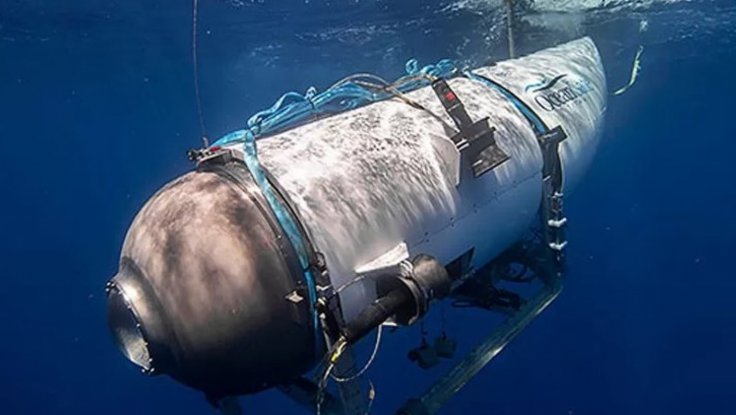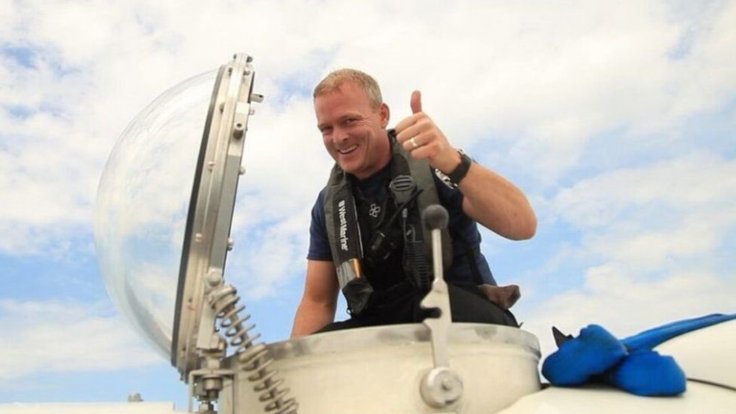The five passengers on board the Titan submersible who died while on their way to explore the Titanic wreckage were likely aware of the impending catastrophe for a minute before the implosion, an expert has said. Spanish engineer and underwater expert José Luis Martín said the passengers were aware of the implosion between 48 and 71 seconds before it occurred.
Martin also described the final moments and said that the scenario was like a "horror movie." He suggested the submersible might have experienced a loss of stability caused by an electrical failure, resulting in a loss of propulsion. This loss of control could have caused the submersible to descend rapidly and vertically toward the seabed, with its porthole facing downward.
Knowing Their Death

Martín presented a timeline outlining the final moments of the ill-fated submersible Titan before it was destroyed on June 18. These events occurred within the first two hours of its dive toward the Titanic shipwreck.
"During the controlled immersion of the Titan, there must have been an electrical fault, which left the craft without thrust," he told the Spanish news outlet NIUS, according to the English language Diario AS.
"Without thrust, the weight of the passengers and the pilot (about 400 kilograms), which was focused on the front end close to the view port, would have disrupted the Titan's longitudinal stability," he explained.
Martín estimated that the submersible started freefalling at a depth of approximately 5,600 feet, and fell "as if it were a stone and without any control." This uncontrolled descent continued for approximately 3,000 feet until it reached a depth of around 8,600 feet.

At this point, the submersible experienced a sudden and significant change in pressure, causing it to rupture and "popped like a balloon."
"At this point, the submersible begins to fall headlong towards the seafloor, and with control and safety functions damaged, it can no longer be maneuvered," Martín theorized in his report.
"The pilot (OceanGate CEO Stockton Rush) couldn't activate the emergency lever to drop weights (and return to the surface)," the expert said, adding that the lever was an inadequate device for such an emergency.
"The Titan changes position and falls like an arrow vertically because the 400 kilos (880 pounds) of passengers that were at the porthole unbalance the submersible," he wrote.

"Everyone rushes and crowds on top of each other. Imagine the horror, the fear, and the agony. It had to be like a horror movie," added Martin, who believes that everything happened during 48 to 71 seconds of free fall.
As the submersible sank towards the bottom of the Atlantic, Martin explained that the depth, combined with the absence of natural light and electricity, would have resulted in complete darkness for the group.

He compared the implosion of the submersible to "puncturing a balloon", emphasizing that it was not solely due to the depth but also the rapid increase in pressure as the sub descended swiftly, akin to a dart.
Encounter with Death
Martín said that the group inside the submersible was fully aware of the gravity of the situation during that time. They would have been conscious of the severity of their circumstances as the submersible experienced the uncontrolled descent and the subsequent increase in pressure.
"In that period of time, they are realizing everything. And what's more, in complete darkness. It's difficult to get an idea of what they experienced in those moments," Martín said.
"As it fell to the depths of the ocean, the hull would have been subjected to a sudden increase in underwater pressure" — leading to a "powerful compression" of the submersible's carbon-fiber hull at a depth of around 9,000 feet, he wrote.
Given that a rapid contraction of the hull would occur, it "would have been out of step with what was happening to the [acrylic] material of the viewport — leading to a micro-fissure and implosion," Martín said.

"After those 48 seconds, or one minute, the implosion and instantaneous sudden death occurs," the expert added.
The implosion of the submersible has been attributed to structural problems with the hull, according to reports.
Professor Stefano Brizzolara, an ocean engineering expert from Virginia Tech, has put forward the hypothesis that the pressure hull of the vessel may have had a defect that ultimately resulted in its fracture under the immense pressure at the depths it reached. This defect could have contributed to the catastrophic implosion of the submersible.
"It is difficult to say what caused the structural failure in this case, but any small material and geometric imperfection, misalignment of connection flanges, tightening torque of bolted connection may have started the structural collapse," Brizzolara told The New York Post.

According to Brizzolara, carbon fiber, the material commonly used in the construction of submersibles like the one that imploded, is susceptible to potential defects.
The expert said that even a small leak at the extreme depths where the submersible was operating would have resulted in water rushing in at an astonishing speed of approximately 620 mph (miles per hour). This rapid influx of water would have been catastrophic, instantly causing the loss of all lives onboard the submersible.
The Titan submersible lost communication with its support vessel on Sunday, June 18, during its descent to the Titanic wreck at a depth of 12,500 feet.
Tragically, all five passengers on board the submersible, including tourists Hamish Harding (58), Shahzada Dawood (48) and his son Sulaiman Dawood (19), French Navy pilot Paul-Henry (PH) Nargeolet, and OceanGate CEO Stockton Rush, lost their lives in the incident.

Four days after the incident, the US Coast Guard officially confirmed the deaths of the victims. An investigation into the implosion of the submersible is ongoing.
There was a delay of eight hours by OceanGate Expeditions in reporting the missing submersible to the US Coast Guard after losing contact.
This led to an extensive international response to rescue the five passengers, with ships from various countries joining the search efforts.
However, as time passed and the estimated oxygen levels decreased, it was announced that the five people aboard the sub were believed to have been killed in a likely implosion.
During the descent, a US Navy monitoring system detected a possible sound associated with the implosion, but search efforts continued.
Subsequently, debris from the imploded submersible was discovered near the Titanic site after the announcement of the passengers' deaths.









